
The Asian hornet is one of the famous IES that settled in Belgium. (Courtesy photo)
Exotic species: prevention is better than cure
After their introduction in new geographical regions, exotic species can spread and proliferate rapidly to settle permanently. Competing with native species for space and resources, they tend to become dominant in their new environment and threaten the local biodiversity by unbalancing local ecosystems. These exotic species, which have excellent adaptation skills, are called Invasive Exotic Species (IES).
Most exotic species implemented outside of their natural distribution do not represent a significant threat for biodiversity: among the 1,200 species spotted in Europe 10 to 15% are considered IES.
The Giant hogweed, the Japanese knotweed, the Canada goose and the Asian hornet are a few of the famous IES that settled in Belgium. Accidentally introduced by humans, as in the case of the Asian hornet, or intentionally brought in for different purposes, as with the Canada goose for hunting game and the Japanese knotweed for garden ornamentation; IES cause adverse impacts on our environment and economy:
- The exotic Eastern gray squirrel is carrier of a virus that decimates the native Red squirrel. Eradication campaigns performed in Belgium are costly.
- The Japanese knotweed smothers native plants and depletes soils. It damages the riverbanks and the nearby infrastructure where it grows. The presence of this plant greatly increases the ground maintenance costs.
- The giant hogweed and Asian hornet may pose public safety risks due to their ability to cause allergic reactions and/or burns when humans encounter them.
IES are usually more competitive and voracious than indigenous species. These characteristics are enhanced by the fact that they are often imported without the band of natural enemies that regulate their populations within their native area. Sometimes, exotic species also carry new pathogens that prove to be lethal for native wildlife. IES can modify physical and/or chemical characteristics of soil and water and by-pass food chains; causing chain reactions leading to a loss of biodiversity.
As usual, prevention is better than cure. Here are few tips to prevent introduction of IES, minimize their dissemination, and eventually preserve the local biodiversity:
- No place for improvisation: before initiating any wildlife management action, it is necessary to learn the precautions to take to avoid making the situation worse or injuring yourself.
- Green waste disposal must always occur within the appropriate recycling center and not by dumping into the wild.
- Take reasonable measures to prevent the loss of green wastes and/or earth from your vehicle during transport.
- Never release any pet or exotic species in the wild. It is harmful for it and for the environment.
- Keep your eyes open! Anyone can play the role of sentinel and contribute to improving knowledge on the distribution of IES in Belgium. Description of IES and how to report their presence can be found here.
By Valentin Wallers, USAG Benelux Environmental Division




